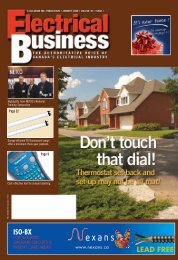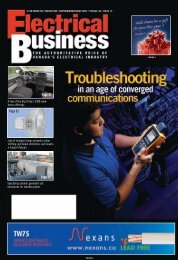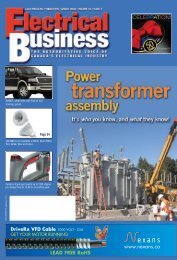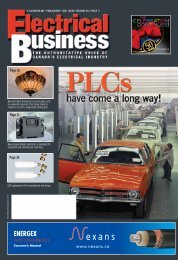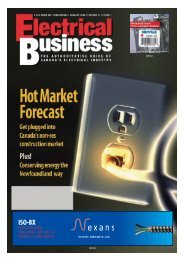September 2006.pdf - Electrical Business Magazine
September 2006.pdf - Electrical Business Magazine
September 2006.pdf - Electrical Business Magazine
Create successful ePaper yourself
Turn your PDF publications into a flip-book with our unique Google optimized e-Paper software.
CODE FILE<br />
By Ted Olechna<br />
Wiring methods<br />
for non-metallic sheathed cable<br />
Non-metallic sheathed cable (NMSC)<br />
is factory assembled with two or more<br />
insulated conductors and may be<br />
fastened directly to a surface in either exposed<br />
or concealed locations. CEC Rule 12-504<br />
tells us NMSC is the preferred choice in/on<br />
buildings of ‘combustible’ construction.<br />
As with other wiring methods, NMSC is<br />
run in continuous lengths between outlet,<br />
junction and panel boxes. Rule 12-506<br />
explains that joints, splices and taps are to<br />
be made in those boxes.<br />
NMSC is temperature rated at 90°C and<br />
is installed in locations where the ambient<br />
temperature doesn’t exceed 30°C. When it<br />
is to be installed in hotter areas, clearances<br />
are provided for the different heating<br />
sources depending on their intensity. The<br />
minimum air space requirements are:<br />
• 25 mm for heating ducts and piping<br />
• 50 mm for masonry and<br />
concrete chimneys<br />
• 150 mm for chimney and flue cleanouts<br />
Additionally, a thermal barrier conforming<br />
to National Building Code requirements<br />
may be installed between the conductor and<br />
heat source to ensure the conductor’s ambient<br />
temperature does not exceed 30°C.<br />
Be careful when bundling NMSCs together<br />
because mutual heating increases their<br />
operating temperature. According to Rule<br />
4-004(10), NMSCs that are run in contact<br />
with one another for more than 600 mm<br />
must be derated using Table 5C. (To avoid<br />
this derating, simply keep cables’ contact<br />
with one another under 600 mm.)<br />
Where NMSC is run between boxes and<br />
fittings, it is supported by straps or other<br />
approved devices within 300 mm of every<br />
box or fitting, and at intervals of not more<br />
Questions and<br />
answers compiled<br />
by Ted Olechna<br />
Tackle the<br />
Code Conundrum...<br />
if you dare<br />
So, you think you know the electrical code, eh Well,<br />
we’ll soon find out if you’re an electrical code junkie or<br />
downright code-clueless. Take a look at the following<br />
questions and check your answers in October’s<br />
<strong>Electrical</strong> <strong>Business</strong>—in print and online at EBmag.com.<br />
How did you do<br />
3 of 3 – Not only are you smart, you love to show off.<br />
1 of 3 – Your understanding of these questions is<br />
not up to code.<br />
2 of 3 – You’re pretty smart, but you still missed one.<br />
0 of 3 – Did you come up with your answers by<br />
playing Eenie, Meenie, Minie, Moe<br />
than 1.5 m throughout the run. Rule 12-510<br />
tells us that NMSC that is either stapled or<br />
run through holes in joists or studs is considered<br />
supported. Of course, be sure not<br />
to damage cables when stapling; one way<br />
to achieve this is to use staples<br />
with penetrationdepth<br />
stops. Unless specifically<br />
approved, staple fasteners<br />
are tested using a<br />
Figure 1<br />
single NMSC (Figure 1).<br />
Mechanical protection<br />
Rule 12-518 requires exposed NMSC to be<br />
adequately protected from mechanical damage<br />
when installed at a height of less than 1.5<br />
m above the floor, or anywhere mechanical<br />
damage could occur. This includes cable<br />
Figure 2<br />
drops from ceilings or walls to appliances.<br />
(Figure 2 shows us a bad installation.)<br />
Protection on lower faces of basement joists<br />
There is some confusion surrounding<br />
acceptable mechanical protection as specified<br />
by Rule 12-514(b) for NMSC installed<br />
on the lower faces of basement joists. Cables<br />
installed immediately adjacent to beams or<br />
ducting (following appropriate clearance<br />
Question 1<br />
Permanently connected diagnostic imaging<br />
equipment may be supplied through<br />
a suitable plug and hard-usage cable or<br />
cord when supplied by branch circuits<br />
not larger than a ___ branch circuit.<br />
a) 20A b) 50A c) 30A d) 40A<br />
Question 2<br />
Wooden structural members supporting<br />
the point of attachment for the overhead<br />
supply conductors to a consumer’s service<br />
shall not be less than ___ in any direction.<br />
a) 25 mm c) 50 mm<br />
b) 38 mm d) 75 mm<br />
Question 3<br />
The station ground resistance shall be<br />
such that, under all soil conditions, the<br />
maximum ground fault current conditions<br />
shall limit the potential rise of all parts of<br />
the station ground grid to ___ .<br />
a) 2500V b) 4000V c) 5000V d) 3500V<br />
considerations) are suitably protected.<br />
Likewise, mechanical protection—such as<br />
running boards (Figure 3)—is required where<br />
cables are not near ducts or beams.<br />
Figure 3<br />
Protection on joists and rafters<br />
Attics are often used as extra storage space,<br />
and materials piled up on top of—or<br />
against—NMSC could compress its insulation<br />
and cause it to deteriorate. This is<br />
why Rule 12-514 instructs us not to run<br />
the cables on the upper faces of ceiling<br />
joists or the lower faces of rafters in attics<br />
or roof spaces when the vertical distance<br />
between the two exceeds 1 m. However,<br />
NMSC runs across rafters in these spaces<br />
are acceptable provided you use a running<br />
board (Figures 4a and 4b).<br />
Answers<br />
Figure 4a<br />
Figure 4b<br />
▼▼▼<br />
to Code Conundrum<br />
<strong>Electrical</strong> <strong>Business</strong> August 2006<br />
Q-1: A neutral conductor that carries only the unbalanced current<br />
from other conductors, as in the case of normally balanced<br />
circuits of three or more conductors, shall be counted in determining<br />
ampacities for copper or aluminum conductors.<br />
B: No. Rule 4-004 (3) A neutral conductor that carries only the<br />
unbalanced current from other conductors, as in the case of normally<br />
balanced circuits of three or more conductors, shall not be<br />
counted in determining ampacities as provided for in Subrules<br />
(1) and (2).<br />
Q-2: What is the basic load for the first 90 m 2 of living area for<br />
a single dwelling when determining the minimum ampacity of<br />
service or feeder conductors<br />
B: 5000 W. Rule 8-200 Single dwellings. (1) The minimum<br />
ampacity of service or feeder conductors supplying a single<br />
dwelling shall be based on the greater of item (a) or (b): (a)(i) a<br />
basic load of 5000 W for the first 90 m 2 of living area.<br />
Q-3: Is a GFCI of the Class A type without a bonding conductor<br />
permitted to be installed at existing outlets where a grounding<br />
means does not exist in the receptacle enclosure<br />
A: Yes. Rule 26-700 (8) Notwithstanding Subrule (7), at existing<br />
outlets where a grounding means does not exist in the receptacle<br />
enclosure, grounding-type receptacles without a bonding conductor<br />
shall be permitted to be installed, provided that each<br />
receptacle is (a) protected by a ground fault circuit interrupter of<br />
the Class A type that is an integral part of this receptacle.<br />
Next month Ted explains the nuances of nonmetallic<br />
sheathed cable wiring methods for<br />
metal stud construction.<br />
Always consult<br />
the electrical inspection<br />
authority in your<br />
province/territory for more<br />
specific interpretations.<br />
Reading someone else's copy<br />
of <strong>Electrical</strong> <strong>Business</strong><br />
Visit<br />
EBmag.com<br />
and click SUBSCRIBE!<br />
Chances are you qualify<br />
for a FREE SUBSCRIPTION.<br />
ADVERTISER INDEX<br />
Advertiser ............................................Page<br />
3M........................................................................6<br />
Apco Skilled Trades............................................12<br />
Arlington ............................................................25<br />
Benshaw ............................................................22<br />
Daimler Chrysler ................................................21<br />
Dimplex North America ......................................15<br />
Electro-Federation Canada ..................................9<br />
Falvo ..................................................................33<br />
Fluke ..................................................................16<br />
Ford....................................................................23<br />
General Electric Lighting ..................................29<br />
Hammond ..........................................................15<br />
Home Depot Supply ..................................10 & 33<br />
I.E.D. Limited Partnership ............................18-19<br />
Ipex ......................................................................7<br />
IPLC Vantera ......................................................20<br />
L. Stoch and Associates ....................................33<br />
Lapp Canada ....................................................28<br />
Legrand/Pass Seymour ......................................13<br />
Magna Electric ..................................................30<br />
Megger Ltd.........................................................17<br />
Milwaukee Electric Tool......................................26<br />
Nexans ................................................................1<br />
Northern Cables ..................................................5<br />
Power Survey......................................................33<br />
Raylew Power Systems ......................................33<br />
Schneider ..................................................27 & 33<br />
Standard Products ......................................2 & 17<br />
Sylvania ............................................................31<br />
Techspan............................................................35<br />
Thomas & Betts ..........................................1 & 36<br />
Underground Devices ........................................22<br />
Wago..................................................................11<br />
Waltech..............................................................33<br />
34 • SEPTEMBER 2006 • www. mag.com





